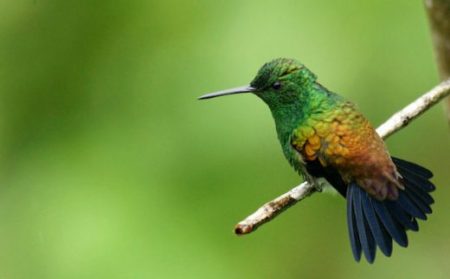Trinidad is home to 18 species of hummingbirds – we are all envious of this diversity! Aliya Hosein shares a folk tale of the role these birds played in the creation of one of Trinidad’s natural wonders—The Pitch Lake—and also some amazing natural history facts about these tiny but mighty birds.
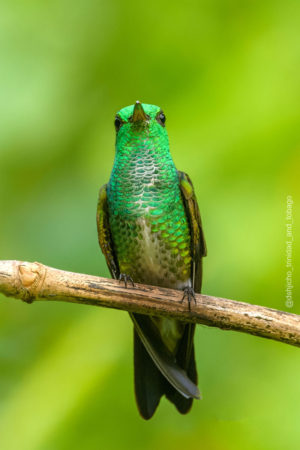
Most cultures around the world have superstitious beliefs, some of which involve birds. In Trinidad and Tobago—and possibly the entire Caribbean region—birds were thought to be messengers of the gods or representation of the gods themselves. Hummingbirds, in particular, were revered by Amerindian tribes. It is reported by historians that Amerindians first named Trinidad, Iere (or Kairi, Caeri) for the hummingbird yerette (or ierette).
These birds are also featured in the story of origin of one of Trinidad’s natural wonders: The Pitch Lake. The Pitch Lake is located in the village of La Brea in southwest Trinidad and covers 100 acres. At its centre it is about 250 feet deep. This Lake is the world’s largest commercial deposit of natural asphalt. It sluggishly replenishes itself causing a “stirring” action in the lake which causes trees and other objects to appear, disappear and re-emerge!
The Pitch Lake was believed to be covered by lush green forest inhabited by an Amerindian tribe. On one day a rival tribe made a sudden attack but the warriors fought with all their might to protect their land. The rival tribe surrendered and left the village as quickly as they could. Only a few huts were damaged.
The tribe was overcome with joy. They wanted to celebrate, but, since the unexpected attack prevented them from hunting that day, they feasted on hummingbirds. They plucked the shimmering feathers off the tiny birds and adorned their own bodies. They carried on with their celebrations paying no attention to their belief that these sacred hummingbirds held the spirits of their ancestors.
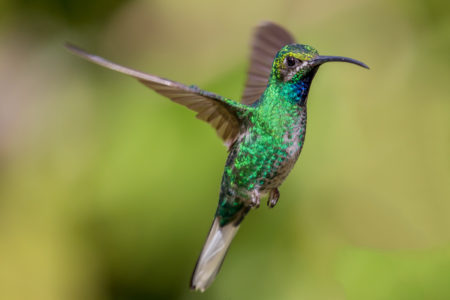
As retribution for their evil deed, the hummingbird gods opened up the ground beneath the village and summoned a lake of pitch that swallowed everything, including the people! The hummingbirds, however, were spared and can now be found throughout the island.
Trinidad and Tobago is home to 18 dazzling species of hummingbirds. Most recently the Glittering-throated Emerald (Amazilia fimbriata) was sighted in the country’s Northern Range bumping the total up to an unofficial 19.
Hummingbirds make up their own bird family. They are tiny, about as heavy as a pack of gum. They have long, narrow bills to sip nectar. Their wings are sabre-shaped for precise flight control. Males, and sometimes females, have small, reflective, colourful feathers on the throat and upper chest. The true intensity of these colours are seen when the hummingbird turns its head to catch the sunlight.
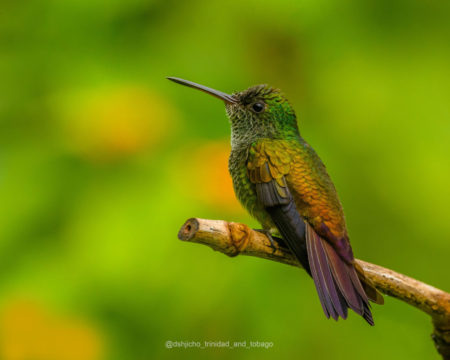
Despite being the smallest of birds, they have been built to live an extraordinary life. As expected, small birds mean small eggs. Hummingbirds lay eggs as tiny as peas in equally tiny cup-shaped nests made from spider webs and leaves. After mating, the female protects and cares for the eggs and chicks by herself.
Hummingbirds have powerful down- and up-beat wing flaps. They are tremendously agile fliers; they are the only vertebrates capable of staying in one place during flight and flying backward and upside-down as well. To the flying acrobatics add speed: their wings beat about 70 times per second in direct flight, and more than 200 times per second while diving.
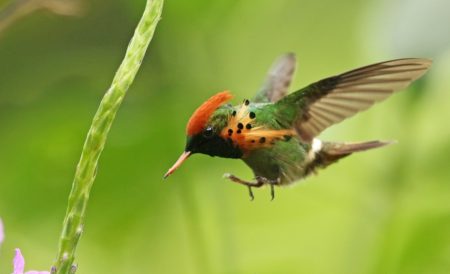
In order to maintain their fast-paced lifestyle, hummingbirds must be able to locate reliable sources of nectar from flowering plants. This explains why their movements are often tied to the changing pattern of flower production over time and space.
Interestingly, hummingbirds do not forage or fend off predators together. They will instead compete with each other for nectar, which explains the hullabaloo around flowering gardens or bird feeders. However, they do have very good reasons for being obnoxious and feisty around flowering plants.
Flowers take time to produce nectar. Hummingbirds therefore wait to feed at flowers in order to lower the risk of losing a tasty meal to other hummingbirds. In areas where many species live together the largest tries to defend small territories where they know they can get the biggest sips of nectar. Since nectar is low in protein, they switch from flowers to insects during the breeding season. They catch small flying insects by hovering in mid-air which are then fed to their growing chicks. If hummingbirds cannot find enough food, they go into a sleep-like state in which their metabolism slows down and body temperature drops to conserve energy.
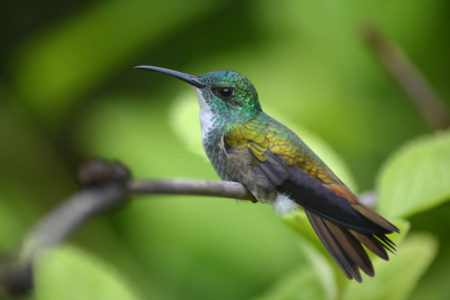
Unfortunately, as human settlements continue to expand, the flowers that hummingbirds prefer are disappearing. The good news is that by planting the right plants (for example: trumpet bush, vervain, powderpuff, and torch lily) in your yard and providing sugar water in hummingbird feeders, you help replace lost food sources.
And you can still help the hummingbirds, even if you are not the ‘gardening’ type, by drinking Bird Friendly certified coffee. When coffee is grown under a diverse canopy of shade trees, coffee plants, the trees that shade them, and the plants that grow on the trees provide a buffet of flowers for these birds and other wildlife that depend upon them.
Hummingbird species recorded in Trinidad and Tobago:
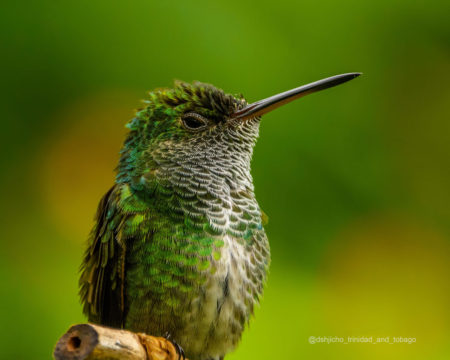
- Amethyst Woodstar (Calliphlox amethystina)
- Copper-rumped Hummingbird (Amazilia tobaci): its subspecies if found only on Tobago
- White- chested Emerald (Amazilia brevirostris)
- Blue-tailed Emerald (Chlorostilbon mellisugus)
- Blue-chinned Sapphire (Chlorestes notata)
- White-necked Jacobin (Florisuga mellivora)
- Black-throated Mango (Anthracothorax nigricollis)
- Green-throated Mango (Anthracothorax viridigula)
- White-tailed Goldenthroat (Polytmus guainumbi)
- Long-billed Starthroat (Heliomaster longirostris)
- Ruby Topaz (Chrysolampis mosquitus): annual visitor to Trinidad
- Tufted Coquette (Lophornis ornatus): the lightest hummingbird recorded for Trinidad
- Green Hermit (Phaethornis guy)
- Rufous-breasted Hermit (Glaucis hirsutus)
- Little Hermit (Phaethornis longuemareus)
- Brown Violetear (Colibri delphinae)- favours high altitudes
- Rufous Shafted Woodstar (Chaetocercus jourdanii)
- White-tailed Sabrewing (Campylopterus ensipennis): listed as Near Threatened by the IUCN, found only on Tobago and Venezuela
Article by Aliya Hosein, member of BirdsCaribbean’s Media Working Group. Aliya works as the Leader of the Welfare and Wildlife Program at the Centre for the Rescue of Endangered Species of Trinidad and Tobago. She is a biologist and avid conservationist, especially fond of parrots and hummingbirds.
